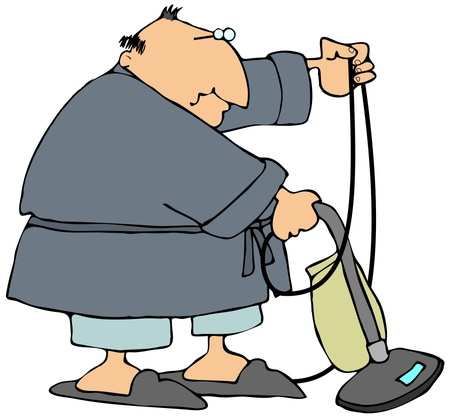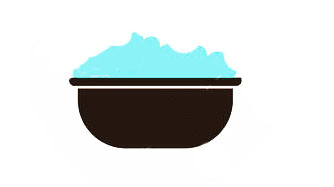
Cleaning of precious collectible carpets is a process that should be carried out with responsibility and care. Once in a possession of an antique rug, a collector (or investor) assumes the role of a true custodian of important artifact and part of the artistic heritage of great importance to future generations.
Many valuable artefacts of weaving arts have been lost to neglect, pets and their owners.
Professional cleaning of antique rugs requires a skill and that skill inevitably comes with a price.
The antique rug that happened to be in your custody, ought to be cleaned at least once every year as the film of dust collected on the surface of the rug will affect its appearance.
Such annual cleaning can be carried out at home, though, and rather inexpensively to boot.

Here is a very simple and effective way to do it:
- Dusting
To get rid of the loose dirt and dust in your rug, turn the rug pile-downwards and vacuum the rug using a commercial vacuum cleaner. Make sure that the head of the vacuum cleaner has some weight; the process essentially consists of beating the dust out.
The process of ‘beating your rug’ is very important; dust left in the foundation will turn into mud when, in later stages, water and shampoo are applied.
- Turn the rug pile-upward and give it another gentle vacuum to extract any dust left in the wool fibres.
2. Washing
Before undertaking this step, look for ‘hot’ jarring colours on your rug.
Such colours ( candy red, for instance) are often synthetic and prone to ‘bleeding’. To ensure the stability of the dye, spit on white cotton cloth and rub it against the ‘suspicious’ area. Saliva is alkaline; it will react with the chemical dye and the cloth will be stained. If this is the case, you are better off sending your rug to a professional. If the cloth has no traces of colour smudging, you are safe to proceed to the next task.
- Fill a buspan with lukewarm water adding cooking salt, commercial vinegar and wool shampoo or detergent. Mix thoroughly
- Using a soft brush, preferably a natural fibre one, clean the carpet moving the brush gently in circular motions against the direction of the pile. Concentrate on small areas (a square foot at most) and dip the brush in the cleaning solution (lukewarm water, vinegar, cooking salt and shampoo) shaking off the excess of water before proceeding further.

You may have to prepare the cleaning solution more than once, if you see it is dirty, or you may simply run out of it if the rug is quite large.
Note that no rinsing is required; the foam will soak into the wool and dissolve completely and without a trace through the encounter with salt and vinegar.
3. Drying
- Once the washing of the carpet is complete. leave it on the sun if possible. Otherwise, if the cleaning is done indoors, use a fan or a heat fan instead. Within a few hours in the sun, a bit longer indoors, your rug with shine with colours.
- The last step is to vacuum gently the rug combing the pile in the right direction (from the top to the bottom). You will notice that all traces of soap residue are gone, and the carpet looks and smells new.

As a responsible custodian of an antique rug, you should NOT wash your rug in a washing machine (you will ruin the foundation of the carpet beyond repair); dry-clean your rug (same effect); water soak your rug (this may cause bleeding of colours); use powered rotary-brush cleaners on your antique rug as they are deigned specifically for wall-to-wall machine-made carpets.
Good luck!
Food for thought: “When someone beats a rug with a stick, he is not beating the rug – his aim is to get rid of the dust … ‘ (-) Rumi
A.G.
Recommended books:
Caroline Bosly Rugs to Riches Unwin Hayman London 1987
Majid Amimi Oriental Rugs – Care and Repair Van Nostrand Reinhold Company, London 1981

It makes sense to leave the rug outdoors to dry in the sun if at all possible. That way, it won’t sour and start to smell off because it didn’t dry properly. My brother is trying to get his rugs and carpets cleaned soon so that his home looks great for potential home buyers that are looking around.
when someone else is beating a rug with a stick, it may be to drive out spirits (JP)
Yes, that’s Rumi
I have the Amini book and checked what he has on cleaning substances. He does not recommend salt of any kind, cooking or other. Even a tiny residual amount can recrystallize and break fibres. A rug so affected becomes chiruk , or sometimes chirook.
Also many commercial vacuum cleaners do have powerful beaters, so I give my pieces a few gentle swats to the backside.
Hello, I am not sure what the purpose of salt is but the idea was shared with me by a very well-known and respected Persian rug repairman from NY. As to beating. IT takes a lot of beating to remove dirt from the rug. If left in the foundation and wetted , it will become mud. When mud is dry so is the foundation, whether cotton or wool. When folder the warps and weft may simply break. I will further investigate re the use of salt
Thank you for explaining that your antique rugs should be cleaned at least once a year. I’ve been wondering how to care for this rug that I just found that appears to be an antique. I’ll be sure to keep this in mind after it gets fully restored.
Dust settles on wool slowly and rugs loose their wonderful liminoisty if left neglected. Thank you for reading